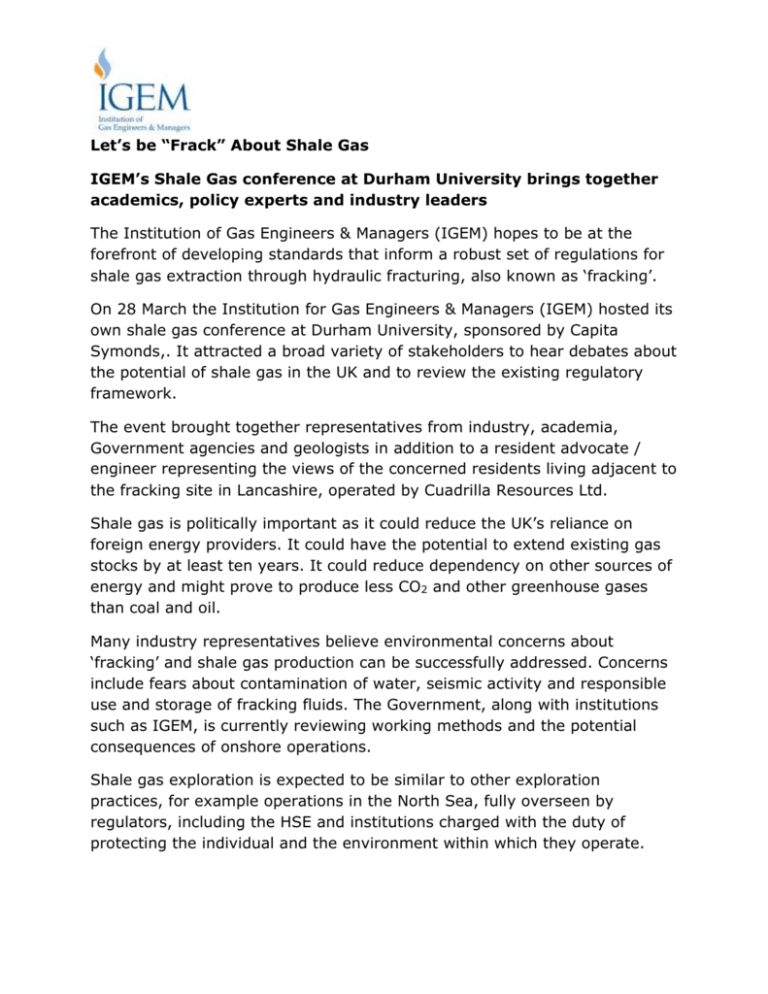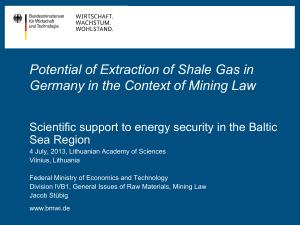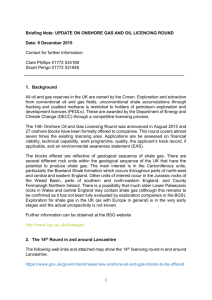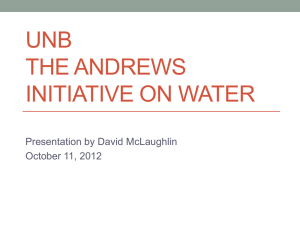Let`s be “Frack” About Shale Gas IGEM`s Shale Gas conference at
advertisement

Let’s be “Frack” About Shale Gas IGEM’s Shale Gas conference at Durham University brings together academics, policy experts and industry leaders The Institution of Gas Engineers & Managers (IGEM) hopes to be at the forefront of developing standards that inform a robust set of regulations for shale gas extraction through hydraulic fracturing, also known as ‘fracking’. On 28 March the Institution for Gas Engineers & Managers (IGEM) hosted its own shale gas conference at Durham University, sponsored by Capita Symonds,. It attracted a broad variety of stakeholders to hear debates about the potential of shale gas in the UK and to review the existing regulatory framework. The event brought together representatives from industry, academia, Government agencies and geologists in addition to a resident advocate / engineer representing the views of the concerned residents living adjacent to the fracking site in Lancashire, operated by Cuadrilla Resources Ltd. Shale gas is politically important as it could reduce the UK’s reliance on foreign energy providers. It could have the potential to extend existing gas stocks by at least ten years. It could reduce dependency on other sources of energy and might prove to produce less CO2 and other greenhouse gases than coal and oil. Many industry representatives believe environmental concerns about ‘fracking’ and shale gas production can be successfully addressed. Concerns include fears about contamination of water, seismic activity and responsible use and storage of fracking fluids. The Government, along with institutions such as IGEM, is currently reviewing working methods and the potential consequences of onshore operations. Shale gas exploration is expected to be similar to other exploration practices, for example operations in the North Sea, fully overseen by regulators, including the HSE and institutions charged with the duty of protecting the individual and the environment within which they operate. It is envisaged that operators should take into account specific issues relating to the operating environment onshore which relate to seismic activity, disposal of fracking fluids and protection of groundwater. She continued: "IGEM sees its role as a regulator to help set standards that ensure the safety and safe practice of hydraulic fracking to enable the successful extraction of onshore gas reserves. IGEM has a range of existing standards which inform the HSE and industry to ensure the safe practice of operating the gas grid. Public concerns “Clearly the public has been alarmed by reports from the US – however these reports are highly misleading and represent an operating environment which is totally alien to British engineering and the UK government”, said Dr Claire Curtis-Thomas, IGEM's Chief Executive Officer, speaking at the conference. “The practices witnessed in the US would never be permitted in the UK. Despite this fact, US images continue to be played out in the public arena potentially causing communities which could benefit from shale gas exploration to reject the investment before even considering the operational proposals. It is therefore important to develop and maintain dialogue with communities to assuage their concerns and deliver the potential of this new energy supply.” Addressing public concerns about “fracking” potentially disturbing domestic life for Lancashire residents, where Cuadrilla has a licence to drill (temporarily on hold), Dr Curtis-Thomas highlighted a similar concerns about telephone masts in the 1990s, with cancer concerns and fears of “people being fried in their beds”. "Public opinion did not prevent authorities from going ahead with building thousands of telephone masts. As an institution we would not support any standards if we thought the practice was unsafe", Dr Curtis-Thomas added. Environmental impacts Tony Grayling, Head of Climate Change at the Environment Agency told the audience the organisation had made visits to established test sites and the UK had to learn lessons from the poor management of environmental standards across the Atlantic. He told the conference: "We are awaiting the independent review of the seismic activity induced by fracking at Preese Hall." "We have made more visits to sites where Cuadrilla has done exploratory drilling and we see no significant risks to groundwater in the sites which have been assessed. In other locations there may be more significant risks." He added:"It is early stages and we are taking it step by step. We need to take the risks seriously. We are conscious that public confidence is low.” Like IGEM, the environment agency recommends flowback water is stored in double-lined tanks. Dr Grayling also clarified that under no circumstances should there be recycling of flowback water. He stated that inappropriate disposal of waste water is covered by the Mining Waste Directive and Environmental Planning Directive 2010. There are also numerous other regulations applying to environmental risks and controls. In relation to underground discharges and leaks he stated there were powers under the Water Resources Act 1991 that require the operator to disclose the chemicals. In relation to fugitive emissions, Offshore installations and Wells Regulations 1996; Borehole Sites and Operations Regulations 1995 (HSE) cover the design, construction and operation of the well too. Assuring the community Fears in the local community are such that Cuadrilla aims to be as “transparent as possible” and publishes all information and data on its website. “When we fracture, invariably we do create seismicity, but this is very small,” stated Huw Clarke exploration geologist from Cuadrilla. “This is usually down to a stress fault near the well bore when we liberate the bore hole. He said that all mining created small seismic shocks but because the coal industry is more established “the coal board never held up their hands, to earth tremors, but we are. He dismissed claims that Cuadrilla “grows fractures from the rock to the water table vertically to contaminate water. “Our wells are some 7,000 ft away from the water table,” he said. He added that each well has seismic censors and investment in 3D seismic imaging will search for fault lines, reducing the impact of small shocks. Meanwhile, Mike Hill countered that there could be an instance where seismicity can cause the cement borehole to fracture. In this case he said that "It doesn't matter if you are 100 m or 10 km below the aqufier - if you get fractured cement, then you get methane migration and under a pressure of 3000 psi it comes up fast and travels a long distance." Dr Curtis-Thomas also made the case that in creating a set of uniform standards, the UK should consider the technology and processes around fracturing, particularly with relation to borehole integrity and design. "In addition to the concerns about water safety and seismology, there needs to be evidence that the concrete and cement used in the borehole design is able to withstand small seismic shocks. There is a duty to regulate the concrete specs and produce a certification and verification and testing that the concrete is to up to spec. Mike Hill's concerns are valid and his demands we feel at IGEM are reasonable." Misinformation erupts Toni Harvey, an exploration geologist for DECC highlighted the danger of public misconception: "It is really important that information is put to the public otherwise you get a lot of disinformation in the press." He cited the Mendip Volcano where a local paper was "convinced that if we drilled down we would release lava into the street!" She said a report on the risk of seismicity in the UK would be published on the department's website later this year. Meanwhile, Professor Richard Selley, mentor of IGEM’s shale gas report author Aaron Pereira revealed that shale gas is “not new”. It was a "cottage industry" in naturally fractured shale rocks as early as 1815. The only new development in shale is fracking – the ability to drill horizontally, he said. "In the UK we have already drilled the Elswick well, without the world coming to an end!” Nick Grealy of the blog No Hot Air and Mike Hill, an engineer representing Lancashire residents also tackled both sides of the debate over public perception versus reality taking stock of residents’ fears and scientific evidence. In addition Tony Baldwin CEO of CNG Services set out the case for a transportation network supported by CNG and potentially shale gas. In summary · · · Possible seismic activity is a risk, however, this can be mitigated by monitoring and abandoning where there is activity during fracking. There have been a set of agreed levels published Ground water contamination can be mitigated by double lining the bore to a depth well below the water table Disposal of contaminated fracking fluid is an issue but with regulation this should be overcome. IGEM’s research into Shale Gas The conference came off the back of IGEM’s report: Shale Gas – A UK Energy Miracle? which makes recommendations for shale gas extraction. The report makes a number of recommendations about storage of flowback water, stating storage tanks should be able to withstand a once in a 300year weather event. It also recommends the need for one body to bring all the standards together. Facts and Figures · In the UK it is estimated that there are 200 tcf trillion cu ft ( could be either 10 to the power of 12 or 10 to the power of 18 depending on whether short or long units). This compares with 3,842 tcf in North America and 3,528 in Asia · · · · The Bowland basin is smaller than the Marcellus shale in North America, but more than 10 times thicker Only 5-15 per cent of the total shale in the UK is recoverable using existing technology. Assuming that the trillion is short and we extract 10 per cent of the reserves it represents about 20 years of UK gas use UK gas usage is about 90 billion cf per annum (figures from DECC) About IGEM The Institution of Gas Engineers and Managers was founded in 1863; awarded a Royal Charter the independent learned Institution undertakes two primary roles: the review of existing and development of new operational standards for the gas industry worldwide and the promotion of professional conduct throughout the sector. The Institution supports a number of expert led independent technical committees which meet on a regular basis to review current operational practises and to make recommendations to improve working conditions. The primary objective of every standard produced is to protect the working individual, the environment within which the individual is working and the public interest. The Institution produces on a regular basis a number of research papers and delivers a range of technical courses which seek to explain the underpinning knowledge of its standards to people working within the sector. The Institutions latest report on Shale Gas is available at the following web link. Reports on bio fuels and hydrogen will be published shortly. The UK gas companies when submitting operational plans to the Health and Safety Executive will refer to the Institutions Gas Standards when making their safety cases.









